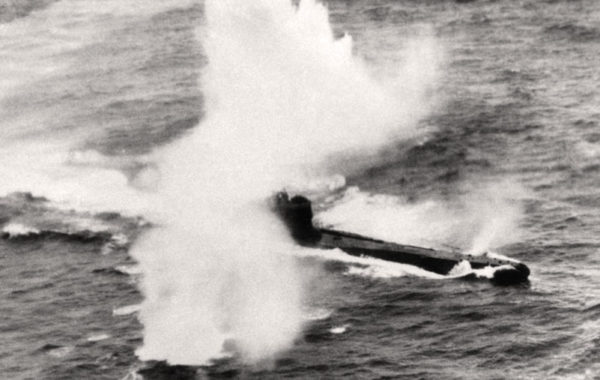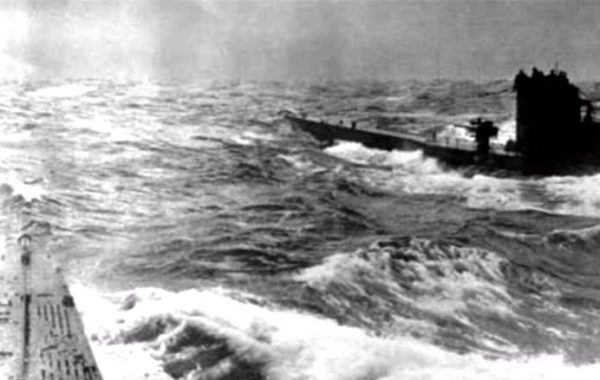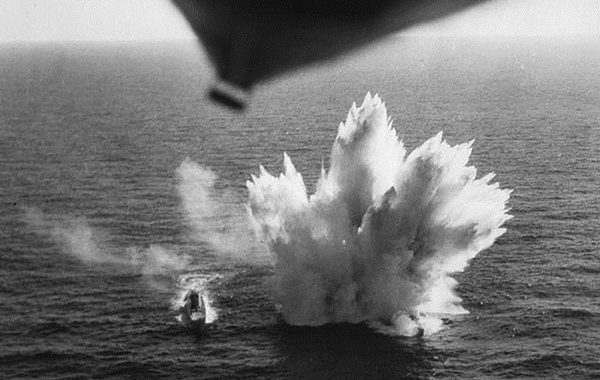When the United States entered World War II in December 1941, it did not take long for Hitler’s U-boats to bring the war to America’s shores. During the first eight months of 1942, U-boats sank more than 600 Allied ships off the East coast and in the Caribbean, before U.S. defenses stiffened. Partly as a consequence of this experience, when British Prime Minister Winston Churchill met with President Franklin Roosevelt in Casablanca in January, 1943, they agreed that war against the U-boats should be a top priority.
That same month, a change in command in Germany would mark the beginning of a long, slow decline in the Nazi submarine threat through the remainder of the war. Adolf Hitler promoted Karl Doenitz, the U-boat fleet commander, to Grand Admiral of the German Navy. Day-to-day command of the submarine fleet passed to Doenitz’s chief of staff, who lacked his boss’s strategic foresight and never gained the unquestioned loyalty of U-boat captains that Doenitz enjoyed.
Several developments began turning the tide of the naval war by mid-1943. The extended range of Allied aircraft meant that U-boats could no longer act with impunity in the mid-Atlantic. Airborne radar, which the Nazis did not think possible, gave Allied planes the opportunity to attack U-boats on the ocean’s surface at night. Improvements in high frequency direction-finding allowed the Allies to locate U-boats whenever they were in communications with their headquarters.
The Allied surface navies benefitted from advances in weaponry and improved tactics. The Hedgehog system fired depth charges in a circular pattern ahead of a suspected U-boat’s anticipated course. Certain charges detonated on contact, while others were time-fused so that even a near miss might explode and damage a U-boat enough to bring it to the surface.
New tactics created special convoy escort groups that began deploying in April of 1943. They consisted of up to ten anti-submarine warships operating in concert with an aircraft carrier and became known as “hunter-killer” groups. Once a U-boat was detected, using sonar, radio frequencies or aerial spotting, a number of the group’s warships would be dispatched to stay on top of the submarine until it had to come to the surface, where it was no match for the firepower of the ships that awaited it.
The hunters had become the hunted.
Following D-day and the invasion of France, the Allies lost 24 merchant ships from September through December of 1944. In that same period, Germany lost 55 U-boats.
From Sept. 3, 1939, to May 8, 1945, roughly 39,000 men took part in U-boat combat operations; 27,500 of those men never returned. U-boats accounted for about 2,700 merchant ships sunk during the war, more than one ship for every day of the war. But their success came at a high price: 87 percent of all U-boats that sailed on operational patrols were sunk or lost, and seven of every ten crew members died at sea.
Submarine History
A Brief History of Submarines, Part 7
After experiencing poor results early in the war, Karl Doenitz, the German U-boat fleet commander, reintroduced his “pack tactic” in the summer of 1940. It called for multiple U-boats to attack a convoy at the same time, a gathering that became known as a “wolf pack.”
The approach was simple in theory. The first U-boat to detect a convoy would alert others and shadow the formation until more U-boats could assemble for the attack. Early in the war, coordination of the attack was given to the senior U-boat commander on the scene. But this proved cumbersome and the results were disappointing.
Doenitz’s revised approach was to have his headquarters coordinate the attacks. Once a shadow boat notified headquarters of a convoy’s direction and speed, the information was relayed to the nearest U-boats. When the pack assembled (each boat reporting as it arrived on station), headquarters alerted the captains of the number of boats in the pack and give the order to attack. U-boat commanders were on their own to attack as they saw fit. The sudden free-for-all was meant to overwhelm Convoy escorts.
The success of the wolf pack was immediately apparent. From June to October 1940, U-boats sank 274 merchant ships for a total of nearly 1.4 million tons of shipping capacity. At the same time, only six U-boats were lost. The number of merchant ships sunk exceeded available replacements, a situation that, if sustained by Germany, would cut the British Isles’ lifeline. Not surprisingly, the period came to be known as “the happy time” for the U-boat fleet.
To achieve its ultimate goal, the wolf pack tactic required construction of many more U-boats and relied on the coded messaging between fleet headquarters and boats at sea provided by the supposedly unbreakable Enigma encryption device.
To answer the first need, U-boat construction was ramping up. By the end of 1941, Doenitz would have 91 operational U-boats. That year, they managed to sink 432 ships amounting to more than two million tons of capacity lost. The number of available U-boats would more than double in 1942, but the tonnage of ships sunk did not keep pace.
The ratio of merchant shipping losses did not continue to grow as the number of U-boats increased, because of several factors. The supposedly unbreakable Enigma device was compromised in mid-1941. British intelligence operatives received a huge boost in breaking the code when the Royal Navy captured an Enigma machine and vital code books from a sinking U-boat. (See blog “Enigma’s Mysteries Revealed,” Oct. 2, 2018.) At the same time, British convoy escorts were devising new, more effective counter measures to deal with wolf packs. And in December of 1941 the United States entered the war following the Japanese attack on Pearl Harbor.
We’ll have more about these developments in our next blog.
A Brief History of Submarines, Part 6
In the first few months of World War II, Germany’s U-boats were tasked with blockading British ports. In carrying out this assignment, U-boat fleet commander Karl Doenitz faced two challenges. The first was a limited number of submarines – only 21 ocean-going boats were available – and the second was their vulnerability to land-based British airpower.
To meet the first challenge, production of Type VII U-boats became a priority in the fall of 1939. The boats were small and took less time to build than larger surface ships. Within a year, German industry developed a system of prefabricating U-boat parts in different locations, which sped up production. Even so, it would take more than a year to begin supplying Doenitz with the number of Type-VII’s he wanted.
To meet the second challenge, Doenitz shifted U-boat operations to the mid-Atlantic, beyond the reach of land-based aircraft.
Working in this “killing zone,” U-boats sank 300,000 tons of allied shipping during the first four months of 1940. But this success came at a grim price: 13 U-boats sunk from January through April.
British convoys, escorted by warships, made merchant shipping difficult for U-boats to attack. The Royal Navy escorts employed radar and an underwater sonic detection system known as ASDIC, to locate German submarines. The more audacious U-boat captains responded by attacking at night, surfacing their boats inside convoy formations. ASDIC could not locate a boat on the surface, and attacking from within the convoy neutralized radar detection because a U-boat was largely indistinguishable on radar screens from the ships it was attacking.
When France fell to Germany in the summer of 1940, Doenitz gained access to ports on the Bay of Biscay. This allowed his U-boats to reach the mid-Atlantic more quickly and stay on station for longer periods.
Up until this point in the war, U-boats had been operating largely on their own. Each boat patrolled a specific area, attacking merchant ships and convoys when they were detected in its combat zone. But this approach was about to change in a way that would dramatically alter the course of the war.
More in our next blog.




